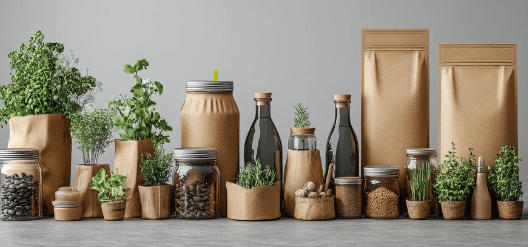The global bioplastics packaging market size was valued at USD 5.80 billion in 2023. The market is projected to grow from USD 6.33 billion in 2024 to USD 14.07 billion by 2032, exhibiting a CAGR of 10.50% during the forecast period.
Bioplastic packaging, which can be bio-based, biodegradable, or both is used for home and personal care products. Unlike traditional plastics, these products break down faster and generate less greenhouse gas emissions. The growing demand for environmentally friendly products is boosting the market. Moreover, chemical manufacturers are investing in bio-based chemicals, expanding the availability of raw materials for products and supporting market growth.

The global pandemic surged the demand for corrugated boxes due to changes in consumer behaviour. The COVID-19 pandemic also contributed to plastic pollution through the rise in single-use plastics such as face shields, gloves, and masks. Additionally, bans on single-use plastics were paused, and there was a shift toward online food deliveries and disposable takeaway containers.
Fortune Business Insights™ provides this information in its research report, titled “Bioplastics Packaging Market, 2024-2032”.
List of Key Players Mentioned in the Report:
- Corbion N.V. (Netherlands)
- Coveris (U.K.)
- Bio Futura (Netherlands)
- Safepack Packaging Solutions (India)
- Amcor Plc. (Australia)
- PLAMFG (U.S.)
- Plantic Technologies (Australia)
- Futamura Group (Japan)
- NatureWorks LLC (U.S.)
- Polymateria Ltd. (U.K.)
Segmentation:
Biodegradable Segment Dominates owing to Rising Consumer Awareness
In terms of material, the market is divided into polybutylene succinate (PBS), biodegradable (starch blends, polylactic acid (PLA), polybutylene adipate terephthalate (PBAT), polyhydroxyalkanoates (PHA), and others), bio-based/non-biodegradable (bio polyethylene terephthalate (PET), bio polyethylene (PE), bio polyamide (PA), bio poly trimethylene terephthalate (PTT), and others). The biodegradable material segment captures the largest bioplastics packaging market share. Growing consumer demand for eco-friendly products is driving the adoption of biodegradable packaging solutions within the bioplastics market.
Rigid Packaging Segment Leads Owing to Strength and Durability
In terms of packaging type, the market for bioplastics packaging is divided into rigid packaging and flexible packaging. The Rigid packaging segment dominates the bioplastic packaging market. Rigid packaging’s robust qualities make it ideal for diverse applications such as food, beverages, pharmaceuticals, and cosmetics, driving its increasing adoption in bioplastics.
Food & Beverage Segment to Dominate Owing to Regulatory Initiatives and Consumer Demand
By end-use industry, the market is divided into food & beverages, pharmaceuticals, cosmetic & personal care, consumer goods, and others. Food & beverage segment holds the largest share as government regulations promoting the use of polymers in food packaging, coupled with consumer preference for nutritional foods.
Bottles Segment Holds the Largest share Owing to Rising Preference for Sustainable Solutions
On the basis of product type, the market is divided into bottles, cups, trays, clamshell, bags, pouch & sachet, and others. he bottles segment is the leading segment, driven by a surge in demand for eco-friendly packaging. Innovations focus on enhancing durability, barrier properties, and recyclability, meeting the growing preference for sustainable solutions in beverages, personal care, and household products.
In terms of region, the market for bioplastics packaging is categorized into Europe, North America, the Asia Pacific, Latin America, and the Middle East & Africa.
Report Coverage:
The market research report offers a comprehensive analysis, covering leading companies, competitive landscape, product/service types, Porter’s five forces analysis, and major end-use industries. It also highlights market trends and key industry developments, along with factors driving market growth in recent years.
Information Source: https://www.fortunebusinessinsights.com/bioplastic-packaging-market-108066
Drivers and Restraints:
Development of Innovative and Advanced Bioplastics to Propel Market Growth
Innovations in bioplastics material science, such as improved durability, heat resistance, and strength, are expanding their application in packaging, especially for preserving products from moisture and oxygen. Moreover, the ability to tailor bioplastics to specific packaging requirements, from flexible films to rigid containers, is attracting adoption across diverse industries, driving market growth and innovation.
However, high land, water, and energy requirements for bioplastic feedstock development lead to environmental concerns and potential legal obstacles, hindering bioplastics packaging market growth.
Regional Insights:
Asia Pacific Leads the Market Owing to Growing Population
Asia Pacific leads due to its rising population and emerging industries such as electronics and food. High fossil fuel prices push manufacturers toward cheaper, renewable bioplastics. This drives innovation and new applications, driven by corporate social responsibility.
Europe is witnessing a significant growth, driven by increased consumption of bioplastics amid rising health concerns, boosting demand for bioplastic products in the region.
Competitive Landscape:
Industry Participants Focus on Offering Innovative Packaging Solutions to Boost their Customer Base
The global bioplastics packaging market is highly fragmented and competitive. A few major players, such as Corbion N.V., Amcor, Berry Coveris, and Bio Futura, dominate the market by offering innovative packaging solutions. These key players are continuously expanding their customer base and driving innovation across regions. Many other companies in the industry are also focused on delivering advanced packaging solutions.
Key Industry Development:
May 2022- Bormioli Pharma introduced EcoPositive, a label covering all its sustainable packaging solutions, such as recycled glass and plastics, bio-based, biodegradable, compostable plastics, and advanced polymer products.


